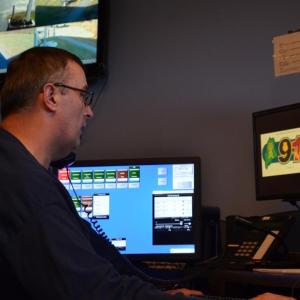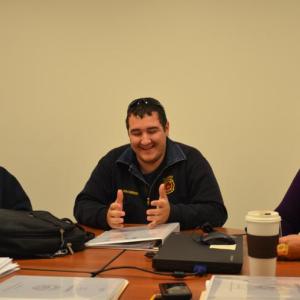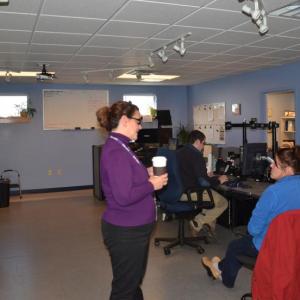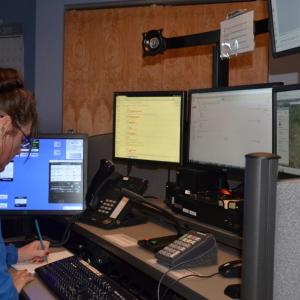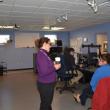Knox RCC: On the front line with every emergency
 Knox Country Regional Communications Center Emergency Dispatcher John Gamage at work. (Photo by Lynda Clancy)
Knox Country Regional Communications Center Emergency Dispatcher John Gamage at work. (Photo by Lynda Clancy)
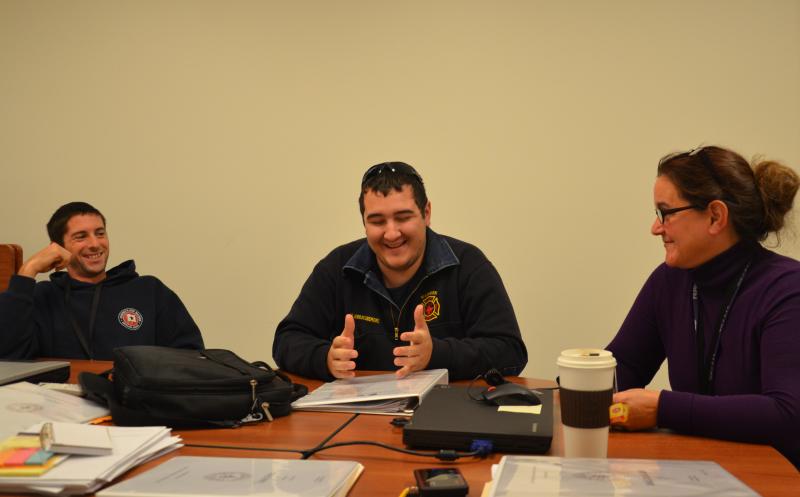 Mike Root, John Dinsmore and Stephanie Gibbs, all Knox County Regional Communications Center dispatchers. (Photo by Lynda Clancy)
Mike Root, John Dinsmore and Stephanie Gibbs, all Knox County Regional Communications Center dispatchers. (Photo by Lynda Clancy)
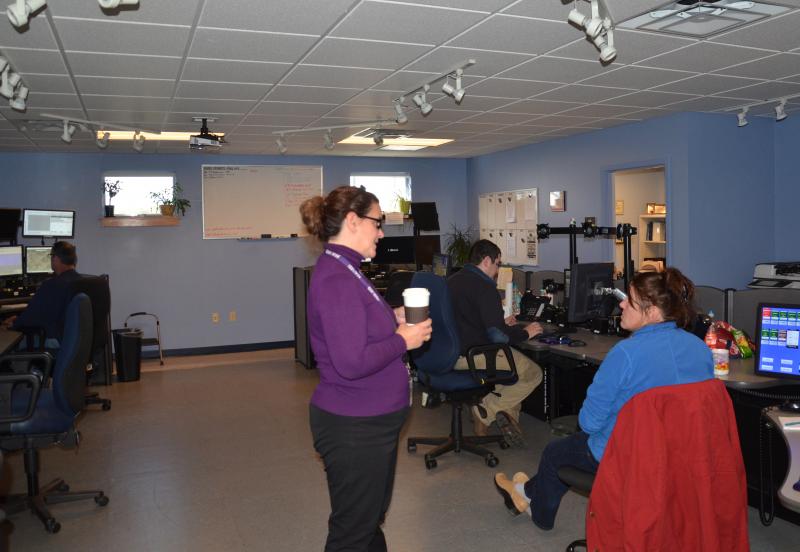 Command central for Knox County Regional Communication.
Command central for Knox County Regional Communication.
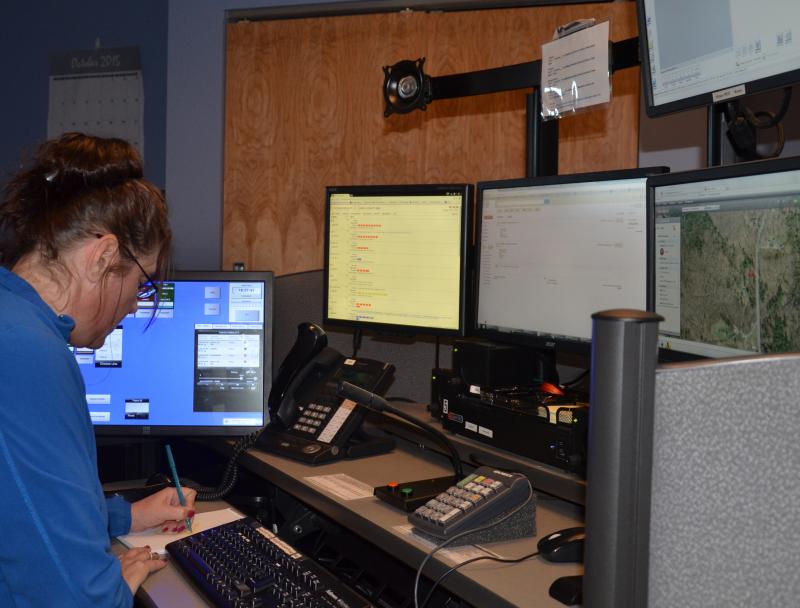 Supervisor Melissa Simmons at work. (Photo by Lynda Clancy)
Supervisor Melissa Simmons at work. (Photo by Lynda Clancy)
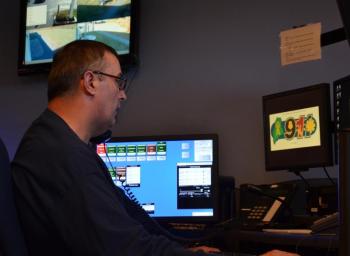 Knox Country Regional Communications Center Emergency Dispatcher John Gamage at work. (Photo by Lynda Clancy)
Knox Country Regional Communications Center Emergency Dispatcher John Gamage at work. (Photo by Lynda Clancy)
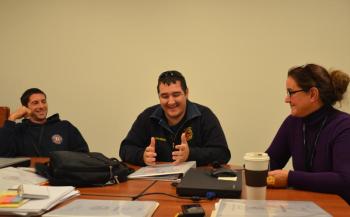 Mike Root, John Dinsmore and Stephanie Gibbs, all Knox County Regional Communications Center dispatchers. (Photo by Lynda Clancy)
Mike Root, John Dinsmore and Stephanie Gibbs, all Knox County Regional Communications Center dispatchers. (Photo by Lynda Clancy)
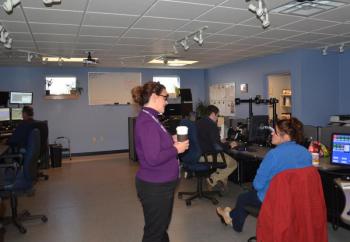 Command central for Knox County Regional Communication.
Command central for Knox County Regional Communication.
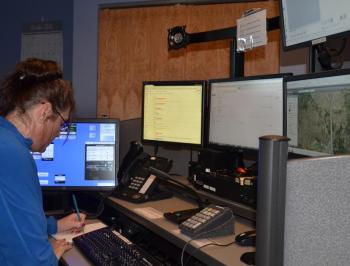 Supervisor Melissa Simmons at work. (Photo by Lynda Clancy)
Supervisor Melissa Simmons at work. (Photo by Lynda Clancy)
ROCKLAND — Tucked in a low-lit room within the Knox Regional Communications Center sits a team of county employees who keep one of the region’s most vital systems at peak performance. This is command central for Knox RCC — as firefighters and cops call it — and is where 12-plus dispatchers pick up the phone whenever anyone in Knox County, from Isle au Haut to Friendship to Washington, dials 911. Their voices are calm and collected, whether the caller is suffering a heart attack, a lone officer on a dangerous beat, or an elderly woman worried about a big squirrel in her house.
Knox RCC mans the front line of emergencies. They are the first, first responders and the dispatchers take the job seriously. They rarely stray from their phone and computer while on duty. They may stretch and walk around the room, but they won’t wander far. If they do, they take a radio with them.
To be a RCC employee requires extensive training, commitment, common sense and integrity. Not to mention an unflappable demeanor and stamina, for the day can go from quiet to a screech in half a second. It is a profession, not a job, said Stephanie Gibbs, an 18-year veteran of Knox RCC, and who is now a supervisor there, along with Melissa Simmons.
“It takes a lot to go through the process,” she said. “You want people who are truthful, and like being behind the scenes. And curious.”
Knox RCC’s director, Linwood Lothrop, calls the operation simply the “911 center” and describes it as the link to public safety services in the county.
“Every call and its outcome is touched in some way by the actions of the center's personnel,” he said.
You won’t see dispatchers marching in parades or at celebrations, or wearing a uniform; but they might just be your neighbor, someone you bump into at the grocery store. Most have lived in the area for years, many have grown up in Knox County. They have the bead on the community and are familiar with human behavior: Thanksgiving and Christmas will be busy, they know, with cooking accidents. Autumn is a time of car-deer crashes.
In the winter, there are the chimney fires and endless rollovers; come summer, boating and swimming accidents. At the holidays, domestic violence and suicide attempts increase. And year-round, there are the drug overdoses.
Every call is treated with gravity, both by dispatchers, and police, fire and EMS. This is the basic tenet of 911. Every dispatcher will tell you that they would rather receive a call than not. And chances are, the majority of individuals in the U.S. will make a call at some point in life to 911.
911 and the Community
Over the past 15 years, the 911 systems across the country, and world, have become more sophisticated and complicated. Just 15 years ago, each municipal police station, county sheriff’s office and state police headquarters ran its own emergency phone network, with staff answering calls at the front desk, and then radioing police, firefighters, medics or animal control officers to the scene.
Wandering Person Program
Knox Regional Communications Center is helping to keep an eye out for individuals who are prone to wander, and who do not know how to get back home.
Working with the Midcoast Regional Development Services, Help Autism Now Services, law enforcement, and Alzheimer’s support groups, Knox RCC is building a database of name and photos.
They keep that list of names and photos in the event someone does wander off. It has come in handy over the past months, as first responders and dispatchers maintain awareness of those who might not recognize their surroundings.
Any resident of Knox County who suffers from an illness or condition that makes them prone to wandering and being disoriented can participate in the program.
The form requires an up-to-date photo of the individual.
To learn more, email KRCC Director Linwood Lothrop, or call him, 594-0429 x118.
All information is kept confidential, Knox RCC said.
One by one, towns and cities joined the county 911 system, and pay each year a fee to the county for the service. Today, Knox RCC is far more technologically advanced than it was even four years ago, and all dispatchers belong to the National Academy of Emergency Dispatchers.
In 2011, Knox County voters approved a $2.5 million upgrade to the RCC’s radio infrastructure, and the department’s move to new offices on Park Street in Rockland.
The system now includes five repeater sites, all of them “hardened with backup generators and, in the most remote sites, they have a battery backup system, as well,” said Lothrop.
Towers on various high spots in the county (on Benner Hill in Rockland, at Tenants Harbor, on Vinalhaven, Ragged Mountain in Camden, and Coggins Hill in Union) enable digital communication.
“They also transmit in simulcast,” said Lothrop. “Therefore all five towers transmit at the same time, ensuring countywide saturation. Audio transmissions from the field units are voted, which means the strongest signal is delivered back to the dispatch center on a microwave back-haul.”
For instance, Camden FD may be out on Route 1 north, and the radio transmission might go to Knox via Vinalhaven, instead of Ragged Mountain, given the strongest signal predominates.
Still, it is the human behind the system that makes it function. And it is the voice of that human which gives comfort, direction and advice in times of vulnerability, even terror.
“It is gratifying to feel like I am making a difference,” said Gibbs. “One of the worst calls I had was from an officer yelling for help. I was the only one hearing him. We got him medical attention and everyone went home at the end of the day.”
Dispatcher Jerrad Dinsmore was on duty during an armed robbery in Union. Within minutes, officers were coming from all directions, and the suspects were flushed out of hiding and arrested.
“You can outrun the police but not the communications,” he said.
Request to hire another team dispatcher
In October, Lothrop asked the County Commissioners and the Knox County Budget Committee to approve adding one more dispatcher position to the Knox RCC budget. Currently, there are 10 dispatchers, two supervisors and Lothrop on the county’s communication budget.
The proposed communications budget for 2016 is $1,041,838. The total proposed Knox County budget for 2016 is $7.2 million, up from $6.8 million of 2015. (See the entire proposed budget here)
In his budgetary request, Lothrop cited a 2010 study that concluded that the Knox 911 Center was inadequately staffed, given the increase in 911 call volume.
In 2010, the center received 112,639 calls. Of those, 12,327 were made to 911. The remaining 100,312 calls were received on nonemergency lines.
In 2014, there were 107,354 calls. Of those calls 22,032 were made to 911, an increase of 78.73 percent from 2010. The remaining 85,322 calls were on nonemergency lines.
Current dispatchers at Knox RCC
Linwood Lothrop, Director
Stephanie Gibbs, Supervisor
Melissa Simmons, Supervisor
Robert Coombs
Melissa Olson
John Gamage
Jarrad Dinsmore
Mike Root
John Harrar
Much of that nonemergency line usage dates back to old habits, pre-911. Many people are not sure they should call 911, or don’t want to bother dispatchers, so they will call the seven-digit administrative line to report potential emergencies, said Lothrop.
“A lot of people are calling out of old habits, on the direct lines to police stations and fire departments,” he said.
In 2015, the projected call volume is 155,000. Of those calls, 15,769 are projected to be 911. (Click here for more data)
As the Midcoast continues to expand with activity, so does the role of dispatch. There are events, such as the Blues Festival, Maine Lobster Festival, Fourth of July celebrations, the Maine Boats, Homes and Harbors Show, Union Fair and Antiques Festival. All of them involve temporarily increasing Knox RCC staff.
“We are also faced with an increasing number of enforcement details that require additional staffing to cover all the radio traffic,” said Lothrop. “This includes seat belt details, OUI enforcement details and safety check roadblocks.”
And then there is mutual aid of municipal fire departments.
“As a fire chief, I would expect to see a well-run communications center that offers ‘one-stop’ shopping for information and resource needs,” said Camden Fire Chief Chris Farley. “Given the integrated delivery of emergency services in today’s world, KRCC is moving in that direction. The ability on the street to talk directly with the center, which takes the information straight from the caller, helps to develop situational awareness of what we might encounter. This helps in the process of formulating a plan and knowing what resources may be needed to provide services to our communities.
Farley is on the Knox RCC executive board, along with Rockland Assistant Fire Chief Adam Miceli, Thomaston Police Chief Kevin Haj, Rockport Police Office Craig Cooley, ambulance paramedic Francis Brandon, Thomaston Ambulance Chief Rusty Barnard, and Knox Emergency Management Director Ray Sisk.
Dispatchers are most useful when there is a situation that requires different agencies — fire departments, ambulances, wardens, foresters, said Farley.
“The ability to speak directly to the center, which is in contact with the various agencies we may be working with, streamlines our ability to deliver emergency services to the area,” he said.
As a example of how a well-functioning dispatch center can help coordinate a response, Farley cited Camden’s December 2008 fire at Bay View Landing, where a hotel under construction was destroyed when a contractor’s heater was left on too close to lumber.
“Our next steps will be to integrate the ability of RCC staff to monitor/record on-scene radio traffic, which will improve the safety and accountability of our emergency services personnel,” he said. “There are growing pains in the process of doing this; however, I think the staff has been putting forth the effort to meet our needs. As the service providing users of the RCC, our challenge is to look at how this accomplished cooperatively as opposed to our own individual needs.”
Knox RCC service “rises to the top,” he said.
People behind the phone
When Gibbs talks about stamina, she is not just referencing the will to sit in a chair for long stretches of time, or working 10-hour shifts four days or nights in a row.
She is talking about the emotional and mental strength a dispatcher must have, as well as the ability to work with the other on-duty dispatchers, when a crisis looms.
The range of calls is wide. Crashes constantly occur on the fast-moving highways of 17, 90, 1, and at their intersections and problematic hills. During the Patriots Day storm of 2007, both Gibbs and Simmons worked nonstop from 7:30 a.m to 11:30 p.m.
There are several high schools, a hospital with psychiatric unit, harbors and lakes, and many people work outside with chain saws and large equipment, in all kinds of weather. Midcoast Maine is not generally sedentary. And, there are the suicides and drug overdoses.
Knox RCC hears it all, and calmly dispatches first responders to the calls. And their calmness helps sooth both the responders and victims at the scene.
Into his third year on the job (it usually takes two years to get fully comfortable and competent as a dispatcher), Dinsmore knows most of the police officers and fire chiefs.
“Everybody sounds familiar to me now,” he said.
He and other seasoned dispatchers are familiar with the landscape and the culture, the frequent offenders and homeless, and many of the elderly home alone and lonely.
He’ll stay on the phone with the caller through sticky situations, while making mandatory radio checks every three minutes with officers at a scene. Dispatchers check in with firefighters every 10 minutes.
“We like to get our officers safely home at night,” he said.
And the number of calls have increased proportionately to the use of cellphones.
“One accident could result in 25 calls by 25 different people,” said Dinsmore.
But the dispatchers would rather hear from callers, even when they spot erratic driving on the roads.
“I would rather people call 911 and be sure, rather someone crashing,” he said.
Talking with individuals in distress requires a trained response, and patience. There is protocol and every question he or she asks the caller is designed to help not just the victims, but the first responders on their way to the scene.
The four universal questions include getting the address of of the incident; the person’s problem (‘Tell me exactly what happened?’); the victim’s age; is she or he conscious; and is he or she breathing.
They are trained to provide pre-arrival instruction in CPR, lifesaving first aid, how to stop bleeding or help deliver babies, before the EMTs actually arrive on scene.
“You are responding to their emergency, and you work with them to calm them down,” said Gibbs.
Callers may get frustrated by those deliberate questions, but dispatchers know that the information must be recorded correctly for the appropriate response. There have been incidents of first responders arriving at the wrong house, and as the local population changes, those street numbers, phone numbers and details become more important to Knox RCC.
House numbers must be properly displayed on the house or mailbox, and visible from the street, said Lothrop.
The dispatchers will relay all information to first responders, such as when driveways are icy, if potentially dangerous dogs are at the door of a victim’s house, even the color of the house or the make of the car in the driveway.
Don’t tell the dispatchers to hurry, says the National Academy of Emergency Dispatchers: “They already know that. Every question they ask has an important reason. That’s why it’s in their protocol.”
On a late autumn day, two recently hired dispatchers were in the conference room at Knox RCC. Mike Root, of Rockland, had been a Rockland volunteer firefighter, and John Harrar, of Owls Head, had been a dispatcher for 16 years, from 1980-1996. They were both familiar with emergency response, but as new dispatchers they had 12 weeks in intensive training ahead of them.
“The basics are the same,” said Harrar. “I always enjoyed it. You are the first person the public talks with, and there is a good feeling in knowing that you are helping them.”
As a firefighter, Root understands how important it is to be sent to the right location, with the right responders on task.
Both of them would be attending the Maine Police Academy in Vassalboro for an 18-week program on emergency dispatch training. That training includes obtaining certification in terminal operator, emergency medical dispatch, and 911 equipment.
Then, they would intern for several weeks, before assuming a station at the phones.
“You don’t need a college degree,” said Gibbs. “You do need integrity and compassion.”
The Knox RCC currently has openings and seeking applicants. Applicants must be high school graduates or equivalent, be able to type 40 words per minute, have excellent communication skills, and have no criminal record. No prior experience is required, and the KRCC is willing to train a qualified candidate.
This work does involve working weekends, overnights and holidays. The county provides a benefits package including health insurance, paid vacation, sick leave and other voluntary benefits. Applications are available on the website at knoxcountymaine.gov or at the County Administrator’s Office in the courthouse.
Reach Editorial Director Lynda Clancy at lyndaclancy@penbaypilot.com; 207-706-6657
Event Date
Address
United States

